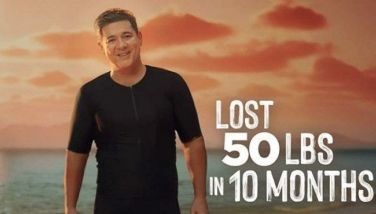The Beach

 You and I and many others besides must have seen Leonardo DiCaprio's latest
starrer, The Beach, by now, perhaps in moviehouses or, brace yourselves,
on videotape. Yes, the video pirates have (again!) beaten the movie's releasing
company, Viva International, to the market, with The Beach being
brazenly shown even, don't look now, in aircon buses to the provinces.
You and I and many others besides must have seen Leonardo DiCaprio's latest
starrer, The Beach, by now, perhaps in moviehouses or, brace yourselves,
on videotape. Yes, the video pirates have (again!) beaten the movie's releasing
company, Viva International, to the market, with The Beach being
brazenly shown even, don't look now, in aircon buses to the provinces.
Anyway, you and I and many others, too, must have gasped in awe at the breath-taking beach in Thailand (in Phi Phi Le, several miles away from Bangkok) where The Beach was shot amidst a controversy stirred up by environmentalists in that country who feared that the filming might destroy trees and other natural life (fishes, etc.) in that virtual paradise.
![]() Fortunately, according to The Beach director Danny Boyle in an
interview early this year in Maui, Hawaii, "We left the place even better than
it was before we went there. Thousands of years from now when we are all dust,
the beach will look exactly the way it looks now. Shooting the movie was such a
humbling experience for me."
Fortunately, according to The Beach director Danny Boyle in an
interview early this year in Maui, Hawaii, "We left the place even better than
it was before we went there. Thousands of years from now when we are all dust,
the beach will look exactly the way it looks now. Shooting the movie was such a
humbling experience for me."
In the same interview, director Boyle revealed that, it's true, the Philippines (with our equally beautiful, if not better, beaches) was initially considered as the setting of the movie.
"In fact," said director Boyle, "we scouted all over Southeast Asia for the setting, going as far as Australia. In the end, we settled for Thailand because the novel is so much about Thailand."
Imagine what a big tourism boost it would have been for the Philippines if the movie was shot here! Eat your heart out, DOT Secretary Gemma Cruz! (Well, better luck next time. The good news is that Tom Cruise is soon coming to the Philippines to shoot a movie about World War II.)
Asked what attracted him to do a movie based upon Alex Garland's 1996 best-selling novel (described by The New York Times as "absorbing" and "a genuine page turner"), director Boyle said, "I've never been to Southeast Asia and the idea of traveling there sounded great. But more than that, it was the idea of working with an international group of people. The Beach is not just an American film or a French film or a British film. It's genuinely a melting pot, an intriguing film for mainstream audiences."
In the next breath, director Boyle disclosed that it was a friend of his who recommended the novel to him.
"I was mesmerized by my friend's description of the island," director Boyle admitted, "and the way Garland described the secret community on the island. Like the story itself, the book's success lies in people passing the word on to each other. We were keen to distance the film from Lord of the Flies which The Beach has been unfairly compared to. Garland's novel is a wonderful parable of modern life -- that nature isn't something we can just waltz into and develop to our taste."
In the movie, the character of Leonardo, Richard, is looking for his paradise, only to end up not finding it, something which Leonardo himself has come to terms with. "I don't think there's a real paradise out there," said Leonardo in the same interview also in Hawaii, "not especially in this day and age. Paradise is something which we can't find anywhere but within ourselves. Having peace of mind is the real paradise on earth."
Leonardo got a staggering $20 million for his work in The Beach (which has been drawing mixed reactions from those who have seen it; some don't like it while others, especially those who have read the novel, love it with a passion). Reports said that had director Boyle enlisted his "signature" actor Ewan McGregor (who starred in his first three directorial jobs, Trainspotting, Shallow Grave and A Life Less Ordinary with Cameron Diaz), the company would have "saved" perhaps three-fourths of Leonardo's talent fee.
Director Boyle only brushed aside any attempt at pitting Leonardo against Ewan, with him caught in-between.
"I must admit that both actors have similarities," said director Boyle. "Each has his own talent which, I think, is God-given. But both come alive the moment they're in front of the camera. They're both such wonderful actors."
How would he, and maybe Leonardo, like the idea of doing a movie in the Philippines?
"Why not?" answered director Boyle. "In the near future... why not?"
Two actors "lost" and "found."
One is Ernie Garcia who usually resurfaces from wherever it is he's "hiding" the rest of the year when the Lenten Season comes around. Ernie is back playing his favorite role, the title role no less in Jesus Christ Superstar (the "traditional" one by Andrew Lloyd Webber and Tim Rice, not the "modernized" version recently staged with Bobby Garcia as director and Basti Artadi as Christ) which was mounted last April 17 in Calamba, Laguna, with more performances on April 29 in Urdaneta, Pangasinan, and on April 30 in Dagupan City.
Not so active in movies now, Ernie devotes most of his time to painting and managing a "summer art workshop" for budding artists.
"I've also been holding exhibits of my work," said Ernie. "I've found a new kind of fulfillment as an artist in what I'm doing now."
The other "lost" and "found" actor is none other than Toffee Calma who decided to lay low (as if he had a choice!) when the MTRCB cracked down on bold flicks. Refusing to be a bold "casualty," Toffee has "reinvented" and "re-positioned" himself, now eyeing serious roles that won't make him bare his over-exposed butt.
"I feel that my acting ability hasn't really been exploited yet," said Toffee (shown somewhere on this page in his new "image"). "Before, I considered acting as fun, not so much serious work."
Coincidentally, Ernie also started as a bold actor, later branching out to theater before finally settling down as a painter. Will Toffee eventually follow a similar direction?
- Latest
- Trending


























 Exclusive
Exclusive







